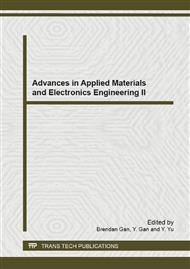p.177
p.182
p.189
p.194
p.198
p.203
p.207
p.212
p.217
Removing Lead Ions from Aqueous Solutions with Sulfur-Impregnated Adsorbents
Abstract:
The removal of lead ions from aqueous solutions was studied using a sulfur-impregnated adsorbent. Coal was mixed with K2S powder and then heated at 800°C for 30 min in nitrogen to produce a sulfur-impregnated adsorbent. The sulfur-impregnated adsorbent prepared had a high sulfur content and high specific surface area. The adsorbent showed a high removal ability for lead ions, and a high removal ratio for lead ions in binary Pb2+-Na+ and Pb2+-Mg2+ solutions. This characteristics were similar to unitary Pb2+ solutions. These results indicate that the sulfur-impregnated adsorbent has a high selective adsorption ability for lead ions in aqueous solutions.
Info:
Periodical:
Pages:
198-202
Citation:
Online since:
April 2013
Authors:
Keywords:
Price:
Сopyright:
© 2013 Trans Tech Publications Ltd. All Rights Reserved
Share:
Citation:


